Evaluation of Qantas Airline Limited Financial Performance 2013-2016
VerifiedAdded on 2020/03/28
|5
|1108
|80
Report
AI Summary
This report provides a detailed evaluation of Qantas Airline Limited's financial performance, analyzing data from 2012 to 2016. It examines key financial metrics such as revenue, expenditure, assets, liabilities, and owner's equity. The analysis reveals trends in revenue growth, cost management, and asset utilization, highlighting the airline's ability to generate profits and manage its financial obligations. The report compares the financial performance across different years, pointing out changes in total assets, liabilities, and equity, and discusses their implications for investors. It recommends that potential investors consider purchasing Qantas shares, while existing shareholders should maintain their support, based on the airline's consistent revenue growth and effective cost control strategies. The report also includes a bibliography of cited sources.
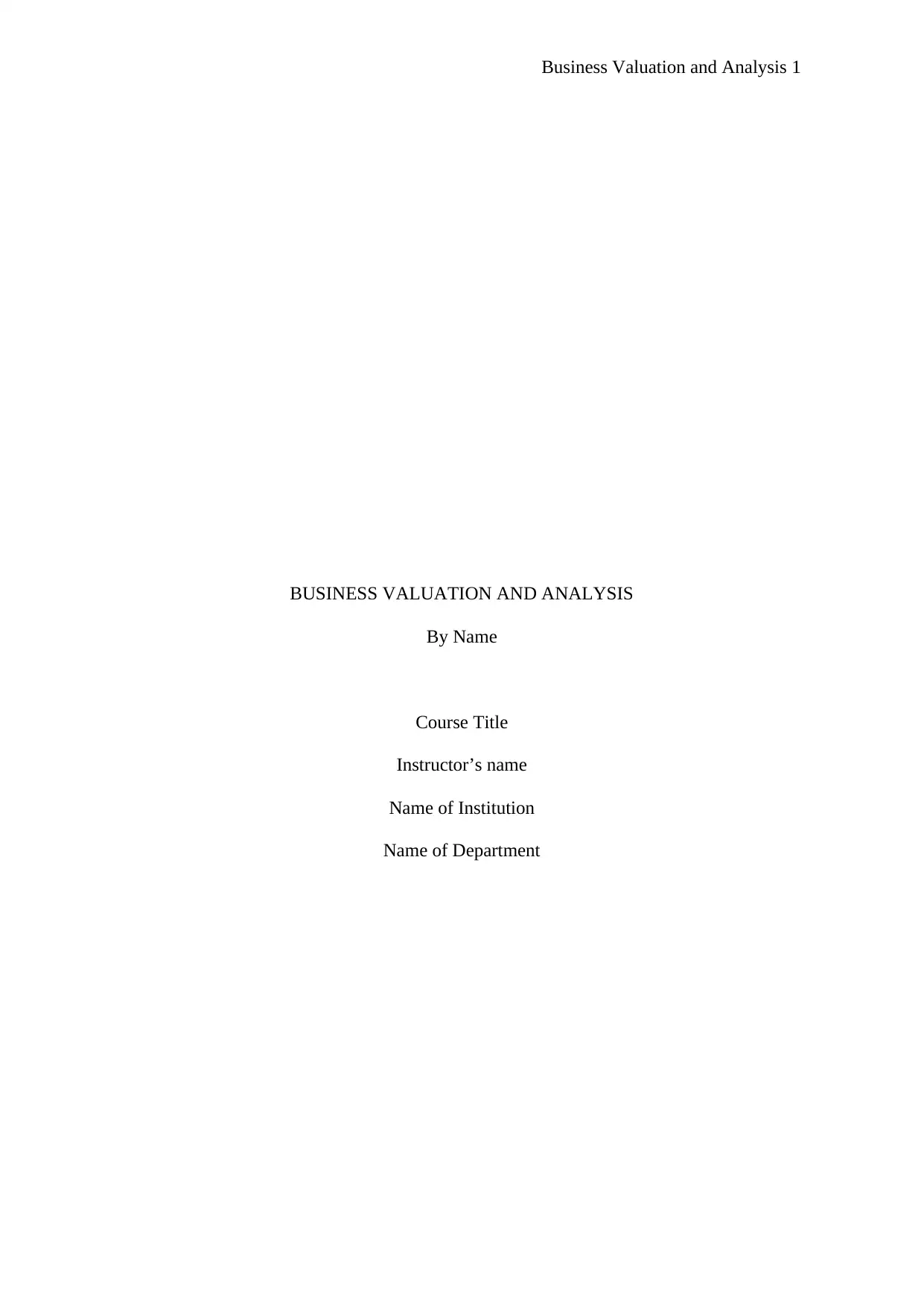
Business Valuation and Analysis 1
BUSINESS VALUATION AND ANALYSIS
By Name
Course Title
Instructor’s name
Name of Institution
Name of Department
BUSINESS VALUATION AND ANALYSIS
By Name
Course Title
Instructor’s name
Name of Institution
Name of Department
Paraphrase This Document
Need a fresh take? Get an instant paraphrase of this document with our AI Paraphraser
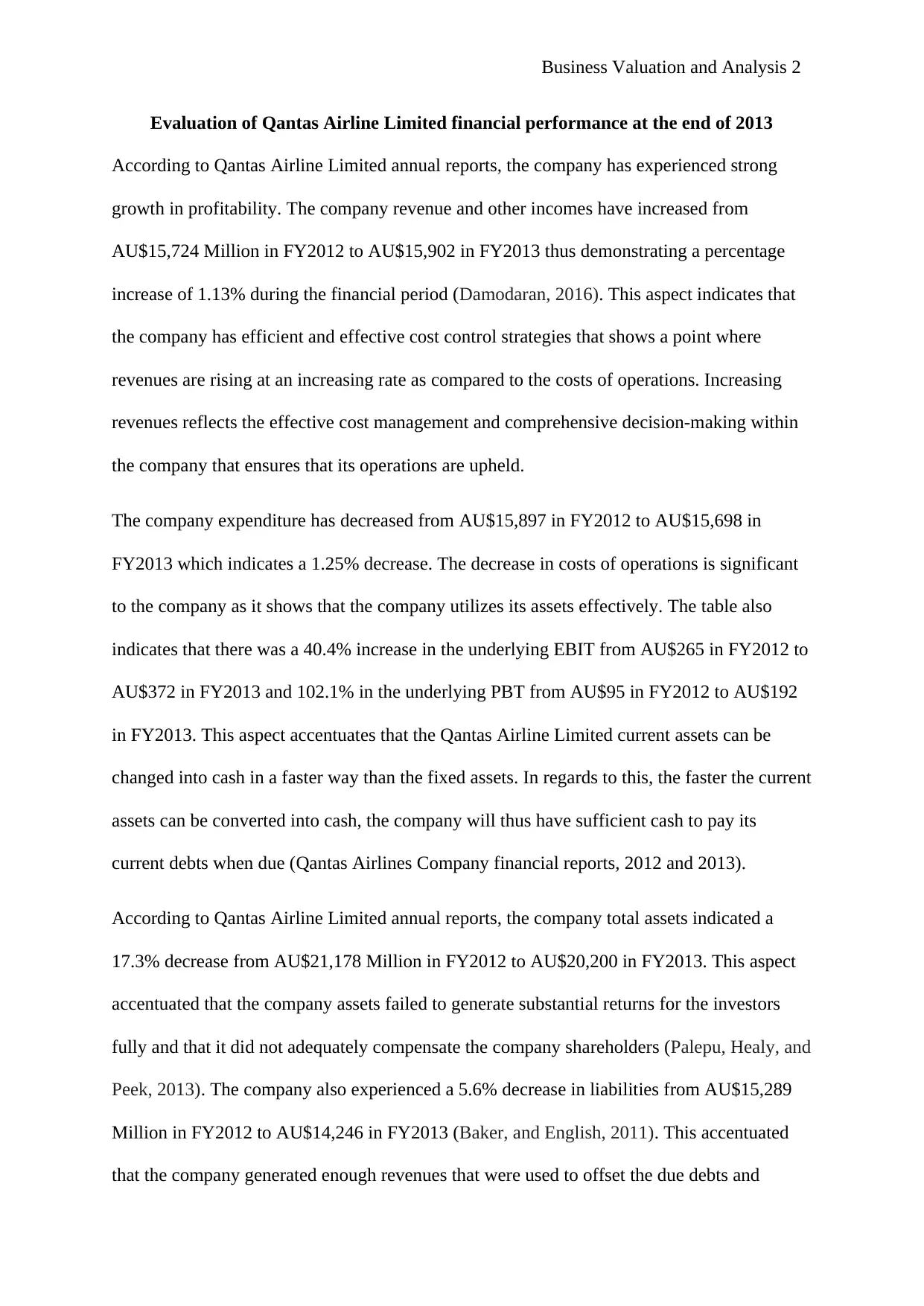
Business Valuation and Analysis 2
Evaluation of Qantas Airline Limited financial performance at the end of 2013
According to Qantas Airline Limited annual reports, the company has experienced strong
growth in profitability. The company revenue and other incomes have increased from
AU$15,724 Million in FY2012 to AU$15,902 in FY2013 thus demonstrating a percentage
increase of 1.13% during the financial period (Damodaran, 2016). This aspect indicates that
the company has efficient and effective cost control strategies that shows a point where
revenues are rising at an increasing rate as compared to the costs of operations. Increasing
revenues reflects the effective cost management and comprehensive decision-making within
the company that ensures that its operations are upheld.
The company expenditure has decreased from AU$15,897 in FY2012 to AU$15,698 in
FY2013 which indicates a 1.25% decrease. The decrease in costs of operations is significant
to the company as it shows that the company utilizes its assets effectively. The table also
indicates that there was a 40.4% increase in the underlying EBIT from AU$265 in FY2012 to
AU$372 in FY2013 and 102.1% in the underlying PBT from AU$95 in FY2012 to AU$192
in FY2013. This aspect accentuates that the Qantas Airline Limited current assets can be
changed into cash in a faster way than the fixed assets. In regards to this, the faster the current
assets can be converted into cash, the company will thus have sufficient cash to pay its
current debts when due (Qantas Airlines Company financial reports, 2012 and 2013).
According to Qantas Airline Limited annual reports, the company total assets indicated a
17.3% decrease from AU$21,178 Million in FY2012 to AU$20,200 in FY2013. This aspect
accentuated that the company assets failed to generate substantial returns for the investors
fully and that it did not adequately compensate the company shareholders (Palepu, Healy, and
Peek, 2013). The company also experienced a 5.6% decrease in liabilities from AU$15,289
Million in FY2012 to AU$14,246 in FY2013 (Baker, and English, 2011). This accentuated
that the company generated enough revenues that were used to offset the due debts and
Evaluation of Qantas Airline Limited financial performance at the end of 2013
According to Qantas Airline Limited annual reports, the company has experienced strong
growth in profitability. The company revenue and other incomes have increased from
AU$15,724 Million in FY2012 to AU$15,902 in FY2013 thus demonstrating a percentage
increase of 1.13% during the financial period (Damodaran, 2016). This aspect indicates that
the company has efficient and effective cost control strategies that shows a point where
revenues are rising at an increasing rate as compared to the costs of operations. Increasing
revenues reflects the effective cost management and comprehensive decision-making within
the company that ensures that its operations are upheld.
The company expenditure has decreased from AU$15,897 in FY2012 to AU$15,698 in
FY2013 which indicates a 1.25% decrease. The decrease in costs of operations is significant
to the company as it shows that the company utilizes its assets effectively. The table also
indicates that there was a 40.4% increase in the underlying EBIT from AU$265 in FY2012 to
AU$372 in FY2013 and 102.1% in the underlying PBT from AU$95 in FY2012 to AU$192
in FY2013. This aspect accentuates that the Qantas Airline Limited current assets can be
changed into cash in a faster way than the fixed assets. In regards to this, the faster the current
assets can be converted into cash, the company will thus have sufficient cash to pay its
current debts when due (Qantas Airlines Company financial reports, 2012 and 2013).
According to Qantas Airline Limited annual reports, the company total assets indicated a
17.3% decrease from AU$21,178 Million in FY2012 to AU$20,200 in FY2013. This aspect
accentuated that the company assets failed to generate substantial returns for the investors
fully and that it did not adequately compensate the company shareholders (Palepu, Healy, and
Peek, 2013). The company also experienced a 5.6% decrease in liabilities from AU$15,289
Million in FY2012 to AU$14,246 in FY2013 (Baker, and English, 2011). This accentuated
that the company generated enough revenues that were used to offset the due debts and
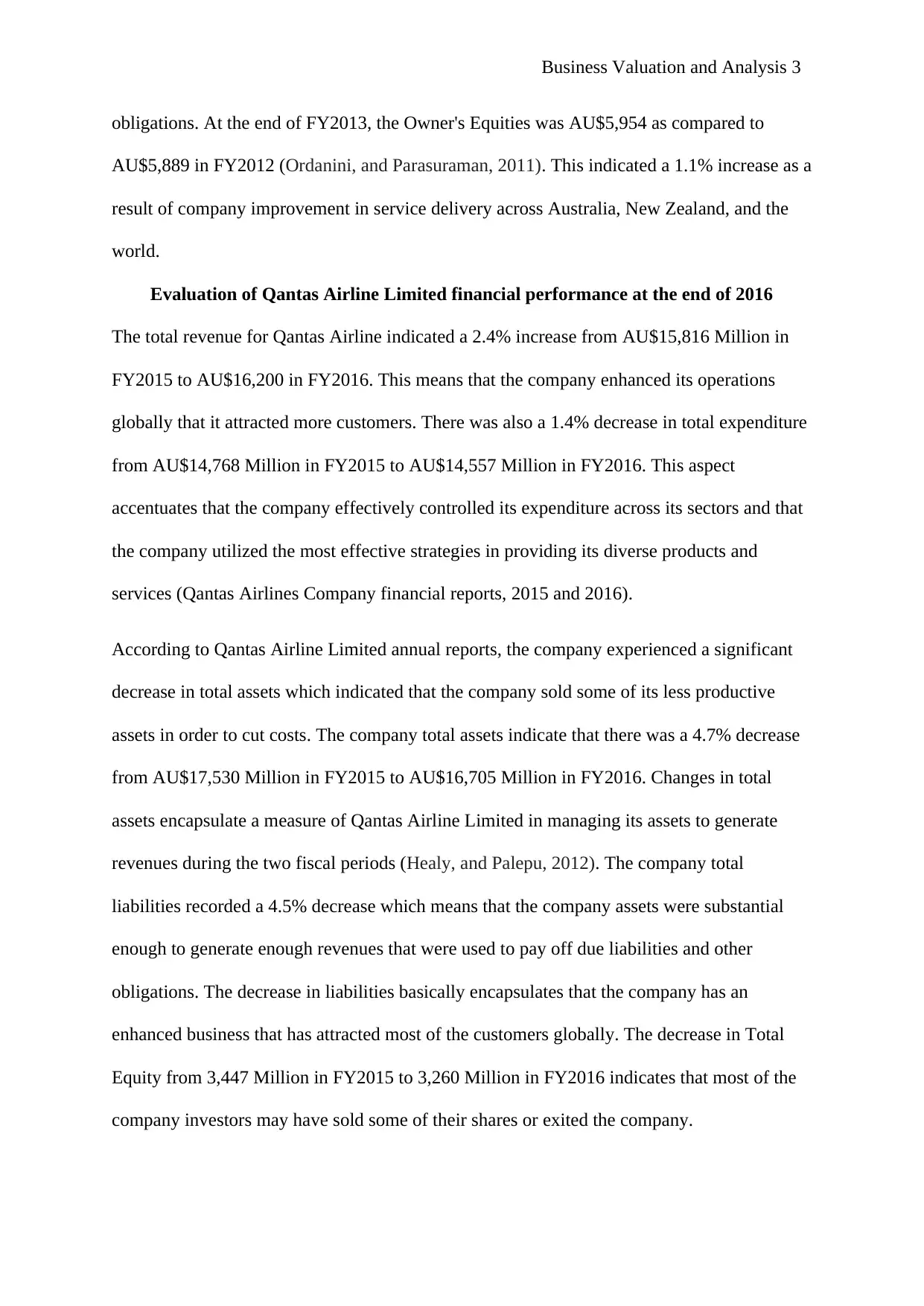
Business Valuation and Analysis 3
obligations. At the end of FY2013, the Owner's Equities was AU$5,954 as compared to
AU$5,889 in FY2012 (Ordanini, and Parasuraman, 2011). This indicated a 1.1% increase as a
result of company improvement in service delivery across Australia, New Zealand, and the
world.
Evaluation of Qantas Airline Limited financial performance at the end of 2016
The total revenue for Qantas Airline indicated a 2.4% increase from AU$15,816 Million in
FY2015 to AU$16,200 in FY2016. This means that the company enhanced its operations
globally that it attracted more customers. There was also a 1.4% decrease in total expenditure
from AU$14,768 Million in FY2015 to AU$14,557 Million in FY2016. This aspect
accentuates that the company effectively controlled its expenditure across its sectors and that
the company utilized the most effective strategies in providing its diverse products and
services (Qantas Airlines Company financial reports, 2015 and 2016).
According to Qantas Airline Limited annual reports, the company experienced a significant
decrease in total assets which indicated that the company sold some of its less productive
assets in order to cut costs. The company total assets indicate that there was a 4.7% decrease
from AU$17,530 Million in FY2015 to AU$16,705 Million in FY2016. Changes in total
assets encapsulate a measure of Qantas Airline Limited in managing its assets to generate
revenues during the two fiscal periods (Healy, and Palepu, 2012). The company total
liabilities recorded a 4.5% decrease which means that the company assets were substantial
enough to generate enough revenues that were used to pay off due liabilities and other
obligations. The decrease in liabilities basically encapsulates that the company has an
enhanced business that has attracted most of the customers globally. The decrease in Total
Equity from 3,447 Million in FY2015 to 3,260 Million in FY2016 indicates that most of the
company investors may have sold some of their shares or exited the company.
obligations. At the end of FY2013, the Owner's Equities was AU$5,954 as compared to
AU$5,889 in FY2012 (Ordanini, and Parasuraman, 2011). This indicated a 1.1% increase as a
result of company improvement in service delivery across Australia, New Zealand, and the
world.
Evaluation of Qantas Airline Limited financial performance at the end of 2016
The total revenue for Qantas Airline indicated a 2.4% increase from AU$15,816 Million in
FY2015 to AU$16,200 in FY2016. This means that the company enhanced its operations
globally that it attracted more customers. There was also a 1.4% decrease in total expenditure
from AU$14,768 Million in FY2015 to AU$14,557 Million in FY2016. This aspect
accentuates that the company effectively controlled its expenditure across its sectors and that
the company utilized the most effective strategies in providing its diverse products and
services (Qantas Airlines Company financial reports, 2015 and 2016).
According to Qantas Airline Limited annual reports, the company experienced a significant
decrease in total assets which indicated that the company sold some of its less productive
assets in order to cut costs. The company total assets indicate that there was a 4.7% decrease
from AU$17,530 Million in FY2015 to AU$16,705 Million in FY2016. Changes in total
assets encapsulate a measure of Qantas Airline Limited in managing its assets to generate
revenues during the two fiscal periods (Healy, and Palepu, 2012). The company total
liabilities recorded a 4.5% decrease which means that the company assets were substantial
enough to generate enough revenues that were used to pay off due liabilities and other
obligations. The decrease in liabilities basically encapsulates that the company has an
enhanced business that has attracted most of the customers globally. The decrease in Total
Equity from 3,447 Million in FY2015 to 3,260 Million in FY2016 indicates that most of the
company investors may have sold some of their shares or exited the company.
⊘ This is a preview!⊘
Do you want full access?
Subscribe today to unlock all pages.

Trusted by 1+ million students worldwide
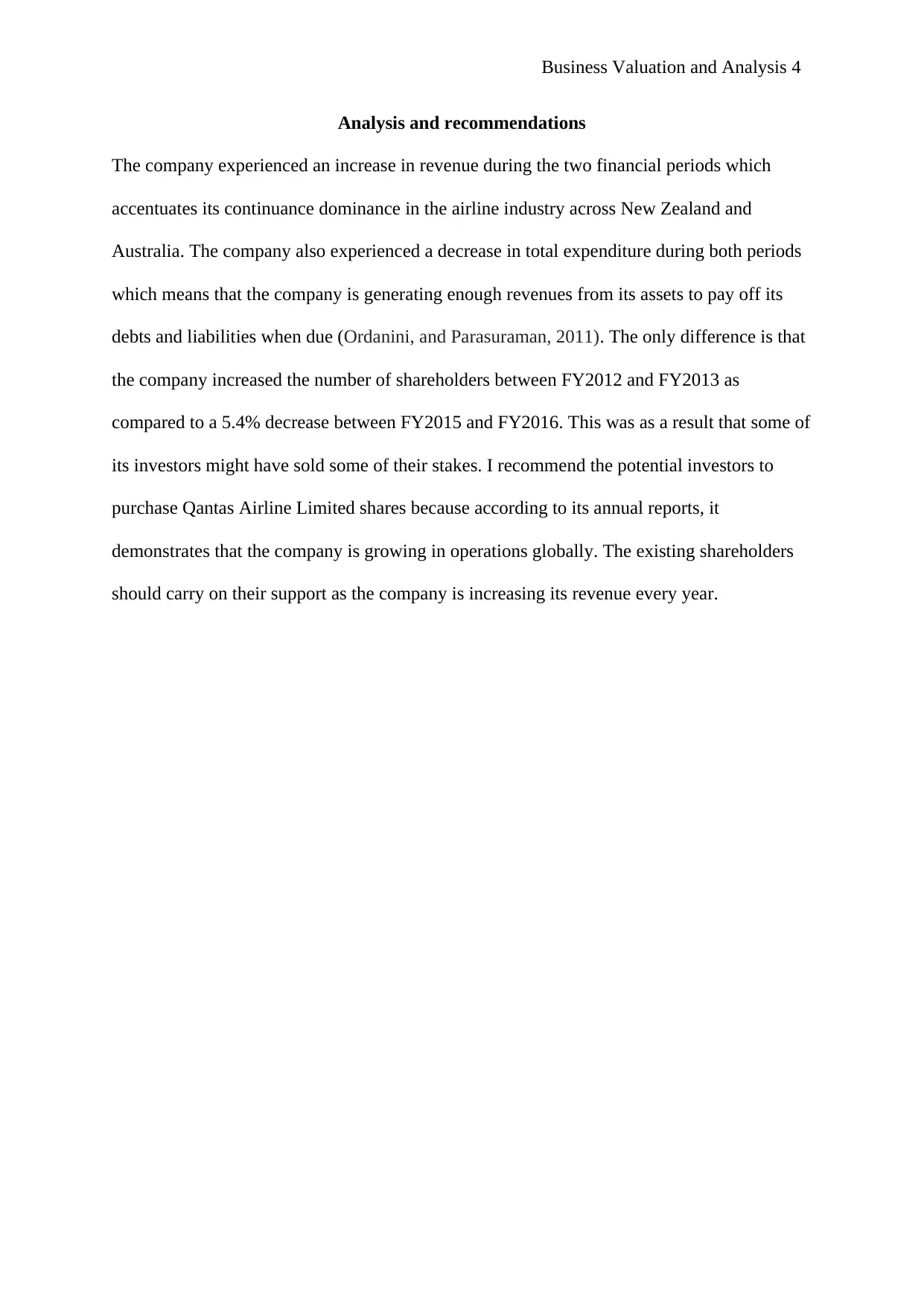
Business Valuation and Analysis 4
Analysis and recommendations
The company experienced an increase in revenue during the two financial periods which
accentuates its continuance dominance in the airline industry across New Zealand and
Australia. The company also experienced a decrease in total expenditure during both periods
which means that the company is generating enough revenues from its assets to pay off its
debts and liabilities when due (Ordanini, and Parasuraman, 2011). The only difference is that
the company increased the number of shareholders between FY2012 and FY2013 as
compared to a 5.4% decrease between FY2015 and FY2016. This was as a result that some of
its investors might have sold some of their stakes. I recommend the potential investors to
purchase Qantas Airline Limited shares because according to its annual reports, it
demonstrates that the company is growing in operations globally. The existing shareholders
should carry on their support as the company is increasing its revenue every year.
Analysis and recommendations
The company experienced an increase in revenue during the two financial periods which
accentuates its continuance dominance in the airline industry across New Zealand and
Australia. The company also experienced a decrease in total expenditure during both periods
which means that the company is generating enough revenues from its assets to pay off its
debts and liabilities when due (Ordanini, and Parasuraman, 2011). The only difference is that
the company increased the number of shareholders between FY2012 and FY2013 as
compared to a 5.4% decrease between FY2015 and FY2016. This was as a result that some of
its investors might have sold some of their stakes. I recommend the potential investors to
purchase Qantas Airline Limited shares because according to its annual reports, it
demonstrates that the company is growing in operations globally. The existing shareholders
should carry on their support as the company is increasing its revenue every year.
Paraphrase This Document
Need a fresh take? Get an instant paraphrase of this document with our AI Paraphraser
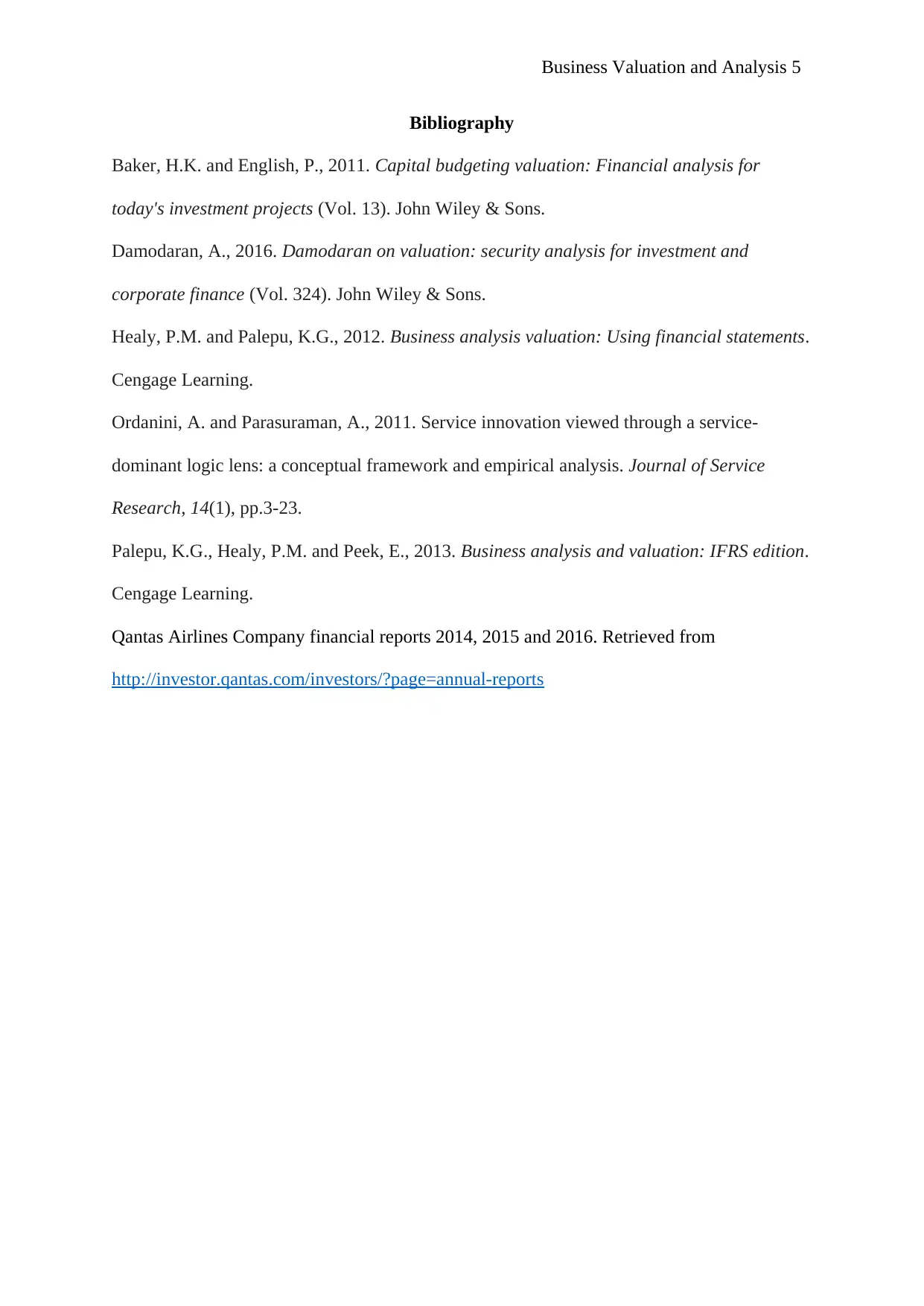
Business Valuation and Analysis 5
Bibliography
Baker, H.K. and English, P., 2011. Capital budgeting valuation: Financial analysis for
today's investment projects (Vol. 13). John Wiley & Sons.
Damodaran, A., 2016. Damodaran on valuation: security analysis for investment and
corporate finance (Vol. 324). John Wiley & Sons.
Healy, P.M. and Palepu, K.G., 2012. Business analysis valuation: Using financial statements.
Cengage Learning.
Ordanini, A. and Parasuraman, A., 2011. Service innovation viewed through a service-
dominant logic lens: a conceptual framework and empirical analysis. Journal of Service
Research, 14(1), pp.3-23.
Palepu, K.G., Healy, P.M. and Peek, E., 2013. Business analysis and valuation: IFRS edition.
Cengage Learning.
Qantas Airlines Company financial reports 2014, 2015 and 2016. Retrieved from
http://investor.qantas.com/investors/?page=annual-reports
Bibliography
Baker, H.K. and English, P., 2011. Capital budgeting valuation: Financial analysis for
today's investment projects (Vol. 13). John Wiley & Sons.
Damodaran, A., 2016. Damodaran on valuation: security analysis for investment and
corporate finance (Vol. 324). John Wiley & Sons.
Healy, P.M. and Palepu, K.G., 2012. Business analysis valuation: Using financial statements.
Cengage Learning.
Ordanini, A. and Parasuraman, A., 2011. Service innovation viewed through a service-
dominant logic lens: a conceptual framework and empirical analysis. Journal of Service
Research, 14(1), pp.3-23.
Palepu, K.G., Healy, P.M. and Peek, E., 2013. Business analysis and valuation: IFRS edition.
Cengage Learning.
Qantas Airlines Company financial reports 2014, 2015 and 2016. Retrieved from
http://investor.qantas.com/investors/?page=annual-reports
1 out of 5
Related Documents
Your All-in-One AI-Powered Toolkit for Academic Success.
+13062052269
info@desklib.com
Available 24*7 on WhatsApp / Email
![[object Object]](/_next/static/media/star-bottom.7253800d.svg)
Unlock your academic potential
Copyright © 2020–2025 A2Z Services. All Rights Reserved. Developed and managed by ZUCOL.





